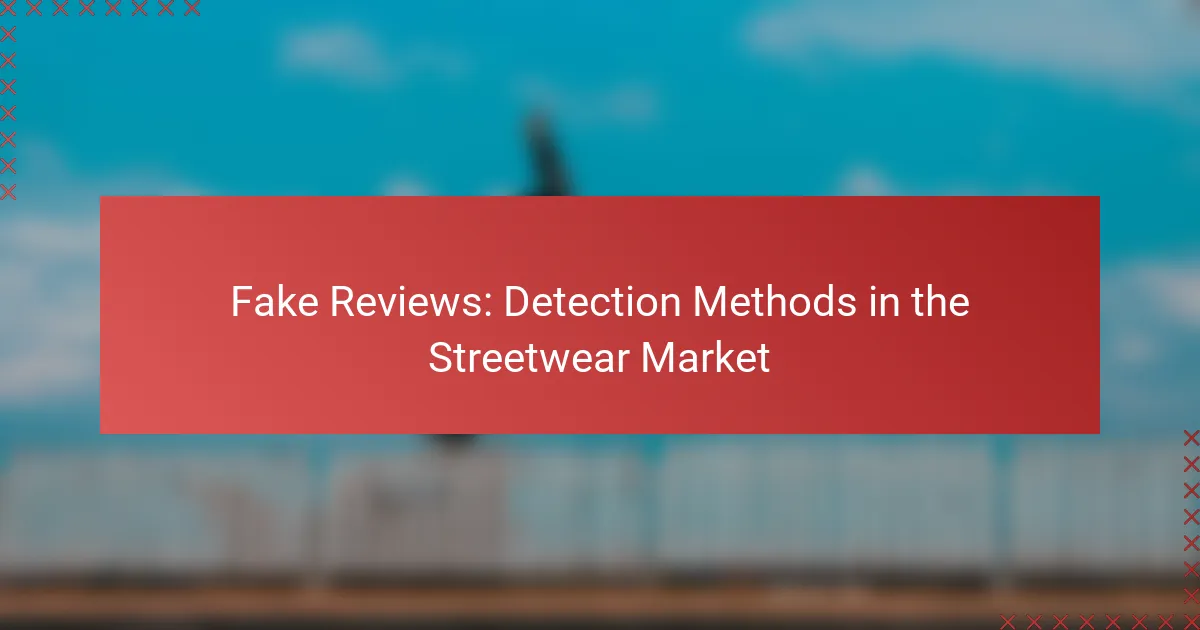In the streetwear market, detecting fake reviews is crucial for consumers seeking authentic feedback. By utilizing advanced technology and analytical techniques, individuals can identify misleading reviews characterized by exaggerated positivity and repetitive language. Various tools are available to analyze review patterns and detect anomalies, empowering consumers to make informed purchasing decisions.
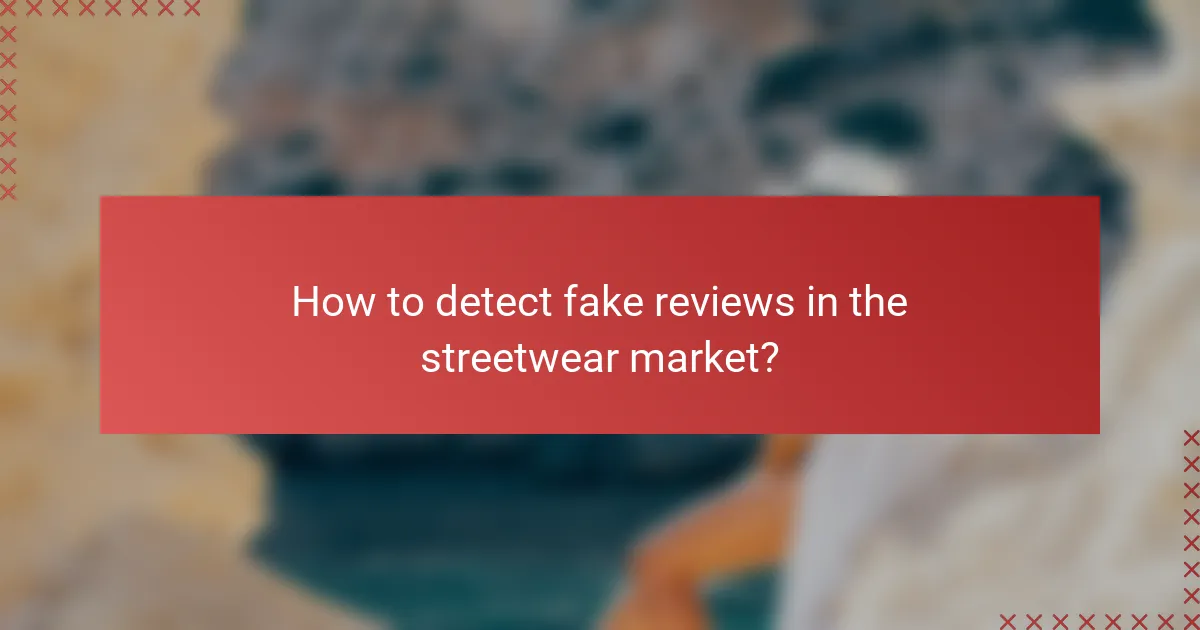
How to detect fake reviews in the streetwear market?
Detecting fake reviews in the streetwear market involves a combination of technology and analytical techniques. By employing advanced tools and scrutinizing patterns, consumers can better identify misleading feedback.
Utilizing AI algorithms
AI algorithms can efficiently analyze large volumes of reviews to identify inconsistencies and patterns indicative of fake feedback. These algorithms often look for anomalies in language, sentiment, and review timing that may suggest manipulation.
For instance, if a product receives a sudden influx of overly positive reviews within a short timeframe, it may signal inauthentic activity. Implementing AI tools can streamline the detection process, allowing brands and consumers to focus on genuine feedback.
Analyzing review patterns
Review patterns can reveal much about the authenticity of feedback. Look for red flags such as repetitive phrases, overly generic comments, or reviews that lack detail about the product. Genuine reviews typically provide specific insights about the item.
Additionally, consider the distribution of ratings. A product with a high number of five-star reviews but few lower ratings may warrant further investigation. A balanced distribution often indicates a more authentic representation of customer experiences.
Cross-referencing with verified purchases
Cross-referencing reviews with verified purchases is a crucial step in confirming authenticity. Many platforms now allow users to filter reviews based on whether the reviewer has actually bought the product. This feature helps to ensure that feedback comes from legitimate customers.
When evaluating reviews, prioritize those marked as verified purchases. This practice can significantly reduce the likelihood of encountering fake reviews and provide a clearer picture of product quality in the streetwear market.
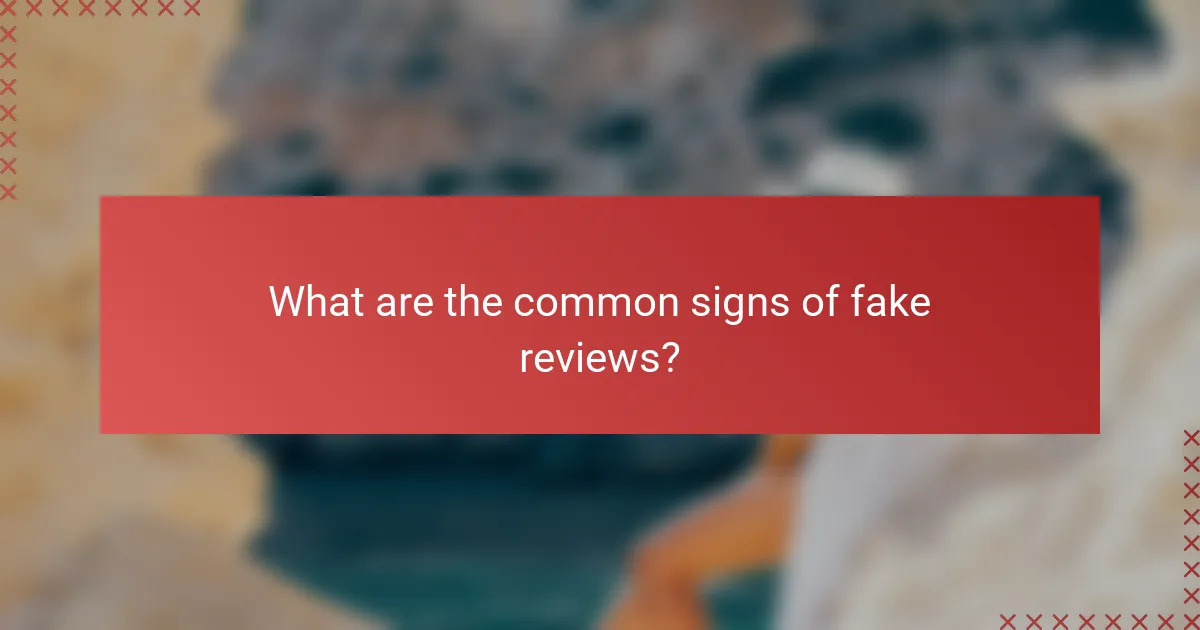
What are the common signs of fake reviews?
Common signs of fake reviews include exaggerated positivity, repetitive language, and accounts that lack verification. Identifying these indicators can help consumers make informed decisions in the streetwear market.
Overly positive language
Fake reviews often contain excessively positive language that seems unnatural. Phrases like “best product ever” or “absolutely perfect” are red flags, especially if they appear frequently across multiple reviews.
Consider the context of the product. Genuine reviews typically include a mix of pros and cons, while fake ones may only highlight the positives. Look for balanced feedback that reflects real user experiences.
Repetitive phrases across reviews
When multiple reviews use the same phrases or wording, it may indicate that they are not authentic. This repetition can suggest that the reviews were generated by the same source or manipulated to create a false impression.
To spot this, read through several reviews and note any similarities in language. If you find identical phrases in numerous reviews, it’s wise to question their legitimacy.
Unverified user accounts
Reviews from unverified user accounts should be approached with caution. These accounts may lack purchase history or have minimal activity, making them less trustworthy.
Check for signs of authenticity, such as a verified purchase badge or a history of diverse reviews. Established platforms often have mechanisms to verify users, which can help ensure the credibility of the feedback.
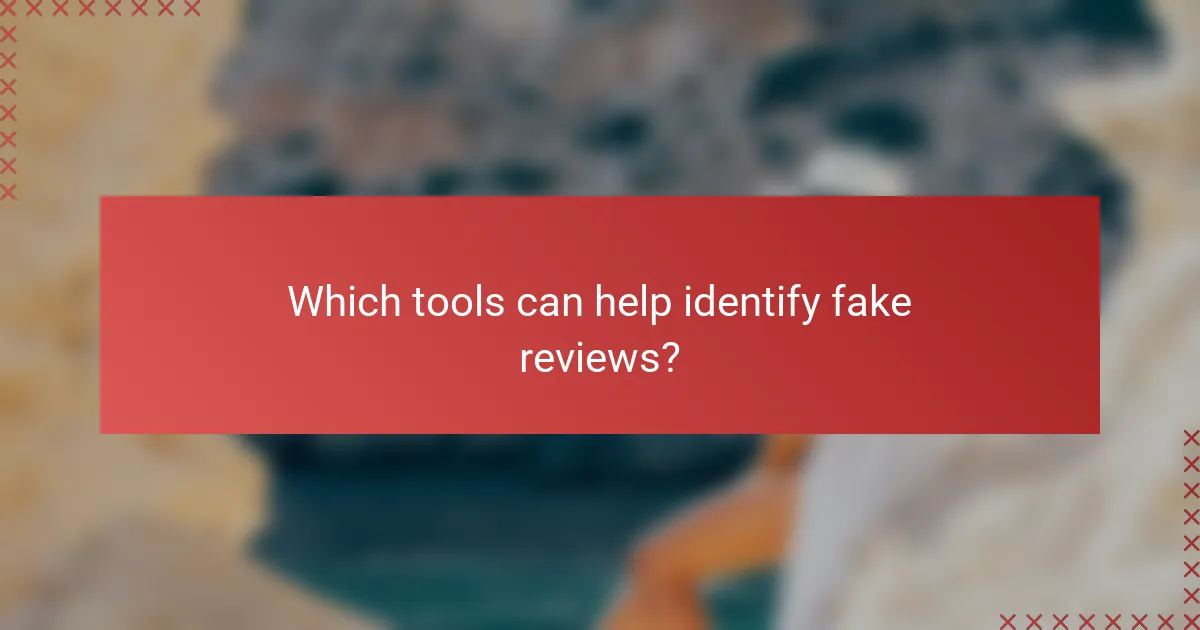
Which tools can help identify fake reviews?
Several tools can assist in identifying fake reviews in the streetwear market. These platforms analyze review patterns, detect anomalies, and provide insights to help consumers make informed decisions.
Fakespot
Fakespot evaluates the authenticity of reviews by analyzing the language, patterns, and reviewer behavior. It assigns a letter grade to products based on the likelihood that the reviews are genuine. Users can simply enter a product URL, and Fakespot will generate a report highlighting potential fake reviews.
When using Fakespot, consider that it primarily focuses on Amazon and other major retailers. While it offers a good starting point, it’s advisable to cross-reference findings with other tools for a more comprehensive assessment.
ReviewMeta
ReviewMeta specializes in analyzing Amazon reviews, providing a detailed breakdown of review authenticity. It uses algorithms to identify suspicious patterns, such as overly positive reviews or repetitive language. Users can paste a product link to receive an analysis that highlights potential red flags.
One key feature of ReviewMeta is its ability to filter out fake reviews from the overall rating, giving a clearer picture of product quality. However, it may not cover all streetwear brands, so users should remain vigilant and consider multiple sources.
Trustpilot
Trustpilot is a widely recognized review platform that allows customers to share their experiences with brands, including streetwear retailers. It employs a verification process to ensure that reviews come from genuine customers, which helps reduce the prevalence of fake reviews.
While Trustpilot is a valuable resource, it’s essential to look at the overall review trends rather than individual ratings. A high number of reviews with similar language or themes may indicate manipulation, so users should analyze the context of the feedback for better insights.

How do fake reviews impact streetwear brands?
Fake reviews can significantly harm streetwear brands by distorting consumer perceptions and undermining trust. These deceptive evaluations can lead to misguided purchasing decisions, ultimately affecting sales and brand loyalty.
Damage to brand reputation
Fake reviews can tarnish a streetwear brand’s reputation by creating a false narrative about product quality and customer satisfaction. When consumers discover that reviews are fabricated, it can lead to a loss of credibility and trust, which are essential in the fashion industry.
Moreover, negative fake reviews can overshadow genuine positive feedback, skewing public perception. Brands may find themselves struggling to regain their standing, as reputation recovery often takes considerable time and effort.
Influence on consumer purchasing decisions
Consumers frequently rely on reviews to guide their purchasing choices, especially in the streetwear market where trends and authenticity are crucial. Fake reviews can mislead potential buyers, causing them to invest in subpar products or overlook high-quality options.
For instance, a streetwear brand with inflated ratings may attract initial interest, but if the actual product fails to meet expectations, it can lead to returns and negative word-of-mouth. Brands should actively monitor reviews and encourage genuine customer feedback to mitigate this risk and maintain a loyal customer base.

What are the legal implications of fake reviews?
Fake reviews can lead to significant legal consequences for both consumers and brands in the streetwear market. Misleading information can violate consumer protection laws, resulting in fines and reputational damage.
Consumer protection laws
Consumer protection laws are designed to safeguard buyers from deceptive practices, including fake reviews. In many jurisdictions, such as the United States and the European Union, these laws mandate that businesses provide truthful information about their products.
Violating these laws can result in penalties, including fines that may reach thousands of dollars. Brands must ensure that any reviews they publish are genuine and not fabricated or incentivized without disclosure.
Potential lawsuits for brands
Brands that engage in or fail to address fake reviews may face lawsuits from consumers or competitors. Legal action can stem from claims of false advertising or unfair competition, which can lead to costly settlements or judgments.
To mitigate risks, brands should implement robust review verification processes and actively monitor feedback. Establishing clear guidelines for soliciting reviews can help maintain compliance with legal standards and protect against potential litigation.
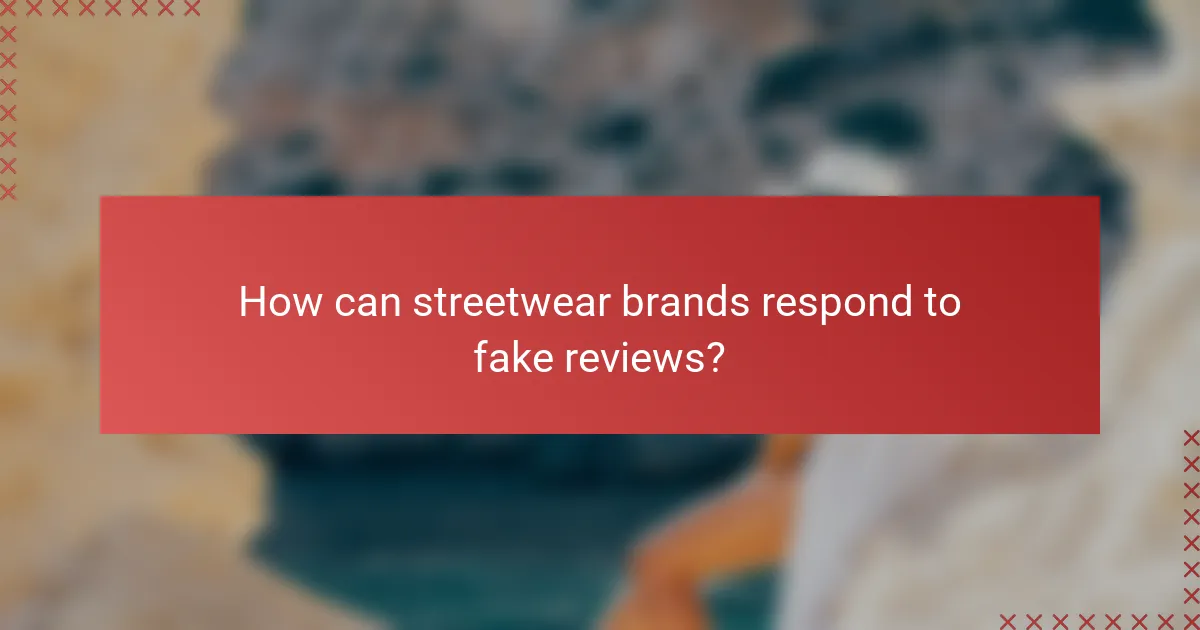
How can streetwear brands respond to fake reviews?
Streetwear brands can effectively combat fake reviews by implementing a combination of proactive monitoring, customer engagement, and transparent practices. These strategies help maintain brand integrity and foster trust among consumers.
Implementing Review Verification Systems
Brands should consider using review verification systems that authenticate the identity of reviewers. This can involve requiring proof of purchase or linking reviews to verified customer accounts. Such measures can significantly reduce the volume of fraudulent feedback.
Additionally, employing algorithms that analyze review patterns can help identify suspicious activity. For instance, a sudden spike in positive reviews from a single source may indicate manipulation.
Encouraging Genuine Customer Feedback
Encouraging authentic customer feedback is crucial. Brands can prompt satisfied customers to leave reviews through follow-up emails or incentives like discounts on future purchases. This approach not only boosts the number of genuine reviews but also enhances customer loyalty.
Offering platforms for customers to share their experiences, such as social media or brand forums, can further promote honest dialogue. Engaging with customers in these spaces allows brands to address concerns and highlight positive testimonials.
Monitoring and Responding to Reviews
Regularly monitoring reviews across platforms is essential for timely responses to fake feedback. Brands should establish a routine for checking reviews on websites like Trustpilot or Google Reviews. Quick responses to negative reviews can mitigate damage and demonstrate commitment to customer satisfaction.
When encountering fake reviews, brands should report them to the platform hosting the reviews. Most review sites have policies against fraudulent content and can assist in removing such entries.
Educating Consumers
Educating consumers about the signs of fake reviews can empower them to make informed decisions. Brands can create content that outlines how to identify suspicious reviews, such as overly generic language or a lack of detail. This not only builds consumer awareness but also positions the brand as a trustworthy source.
Additionally, providing transparency about the review process, including how reviews are collected and verified, can enhance credibility. Brands that openly share their practices are more likely to gain consumer trust.
